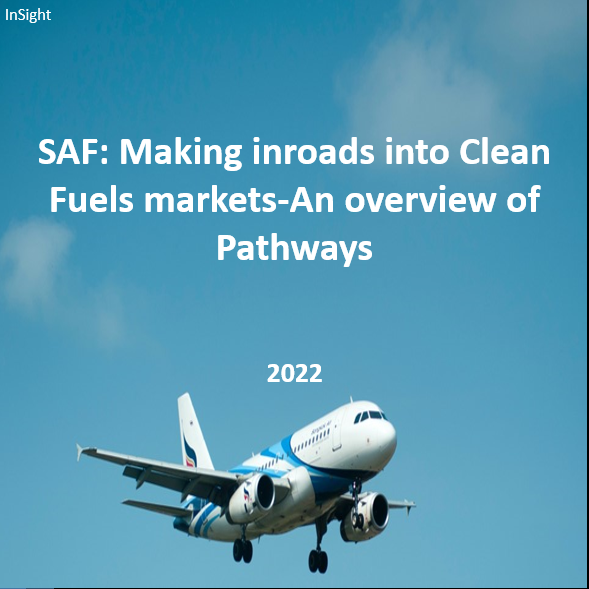- Home
- Markets
- Cap & Trade
- Clean Fuels Standard
- Carbon Offsets
- Carbon Linked Mechanisms
- Get to Know
- Market Coverage
- Cap & Trade
- Clean Fuels Standard
- Carbon Offsets
- Carbon Linked Mechanisms
- Use Cases
- About us
- Membership Plans
- InSights
- Webinars
- Scenario Simulators
- CAFÉ
- CAFÉ – Carbon Analysis Forecasting Engine Enter my CAFÉ
- Cap-and-Trade
- Clean Fuel Standards
- Carbon Offsets
- InSights
- SAF: Making inroads into Clean Fuels markets-An overview of pathways | Insight Report | June 2022
SAF: Making inroads into Clean Fuels markets-An overview of pathways | Insight Report | June 2022Wednesday, 1st June 2022
Aviation accounts for approximately 2.4% of global COâ‚‚ emissions. In view of the current state of the global climate crisis, it becomes imperative to curb emissions. SAF is a biofuel which is chemically similar to conventional jet fuels and is one of the prominent solutions to decarbonize the aviation sector. It can be produced from renewable sources such as waste oils, municipal waste and non-food crops. With a carbon footprint much lower than conventional fossil fuels, SAF can help reduce COâ‚‚ emissions by up to 80%. With environmental regulations growing increasingly stringent across the globe, the demand for SAF is expected to pick up in the coming years. There are different technology pathways available for producing SAF. Currently, the ASTM D7566 lists seven approved pathways for the production of drop-in SAF. In addition, the ASTM D1655 lists two pathways for co-processing biomass-based feedstocks along with fossil fuels.
This report is for members only. Purchase Report
Explore Membership Options to get access to this InSightcCarbon has mapped both the demand as well as supply of SAF to size the market. The research indicates that global SAF consumption in 2022 (as per offtake agreements) stood at 494 million litres.See MembershipsYou might also likeRGGI Market: Forecasting the Landscape | Analyst Note | April 2024 Alberta TIER Market Analyst Note: A new model for North American carbon markets | Analyst Note | April 2024 California LCFS Market Outlook Ahead of New Regulations Coming In | Analyst Note | April 2024 View All Analyst NotesAnalyst Notes
Outlook for Voluntary Renewable Energy and Unbundled Voluntary Certificates in the USA | Insight Report | February 2024 North American Renewable Natural Gas Outlook 2030 | Insight Report | January 2024 North American Renewable Diesel Outlook 2030 | Insight Report | October 2023 View All Insight ForecastInsight Forecast





- No data Found!
Free Trial or Login to access
Our market portals and InSights are only for logged-in users with the relevant access. This can be you too…
Your Current Membership Does not Include this Content
This content is outside of your current package. If you need this too, let’s talk…
Solve Your Problems
Send this problem to our Clients team, and we will get back to you shortly with a plan of attack.
orSpeak and exchange notes with our specific-market expert, use your complimentary hours.
Arrange with Client TeamLet's Connect
Tell us who you are, and what you're after. We'll find you the right person with the answer - before you wake up twice.
Request Access to Data Tool
Tell us who you are, and what you're after. We'll find you the right person with the answer - before you wake up twice.
Newsletter Sign Up
Your name and email in exchange for staying up to date across the world's environmental markets... what a deal?!
MEMBERSHIPS
Sign Up for Free Trial or Login to Access Market Dashboard
Your Current Membership Does not Include this Content
This content is outside of your current package.
If you need this too, let's talk…My Saved Selections
Phasellus tempor tincidunt sem, sed dictum ipsum mollis vitae. Maecenas eu diam convallis, pellentesque lacus et, mollis enim.
ID # Custom Name Created On Insert From My Saved Selections
Phasellus tempor tincidunt sem, sed dictum ipsum mollis vitae. Maecenas eu diam convallis, pellentesque lacus et, mollis enim.
# ID Custom Name Created On My pinned contentThere is no pinned content to display - Clean Fuel Standards
- Clean Fuels Standard
- Cap & Trade
- Clean Fuels Standard
- Cap & Trade


 Webinar
Webinar